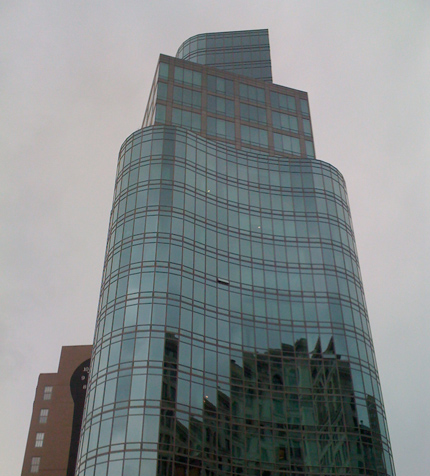
445 Lafayette Place, designed by Charles Gwathmey
People in glass apartments shouldn’t throw stones or other projectiles. Nor should they engage in private acts directly in front of their floor to ceiling windows. Yet lately there has been a rash of exhibitionism throughout New York City owing to an increase in floor to ceiling windowed buildings. Influenced in part by Richard Meier’s glass box towers in lower Manhattan (and his newest one at One Grand Army Plaza in Brooklyn), these transparent living spaces, once the quintessence of twenty first century Modernism, have become eyesores, particularly at night when they take on the appearance of showrooms in Amsterdam’s red light district.
How often have you walked down streets where you’ve seen much more of another person’s life and lifestyle than necessary? Yet like a moth drawn to light you couldn’t resist?
You’d think there should be a law. Indeed there are peeping Tom statutes on the books. A Tom is a person who, according to uslegal.com, “stealthily peeks into windows, other openings with the purpose of getting a sexual thrill from seeing women or girls undressed or couples making love. It is a slang term for a voyeur. Being a peeping Tom is treated as a crime based on sexual deviancy, according to state laws, which vary by state. The victim of a peeping Tom can bring a lawsuit for invasion of privacy.”
Granted simply walking down the street and inadvertently peering into a window does not constitute “secret or surreptitious” trespassing on another’s privacy, but it does beg the question: Why would anyone want their intimate life exposed to any peeping Tom, Dick or Harry? In other words, what were the architects thinking? And why are so many developers buying into this aesthetic?
In the 1949 film version of Ayn Rand’s over-wrought The Fountainhead, starring Gary Cooper as the “visionary” architect Howard Roark, a residential skyscraper looms over Central Park with its terraced glass facade shimmering in the sun. The structure represented the victorious struggle of iconic Modernism over tired classicism. It further symbolized Rand’s ideal of the supreme individualist combating mass conformity. Any high school and college student aspiring to iconoclasm envies Roark’s tenacious insistence on artistic integrity — the integrity of the devout modernist for whom rightness of form trumps the needs of many. Curiously his fictional buildings, perversely rooted in Bauhaus aesthetics, reveal a preference for glass curtain walls, which in real life on Park Avenue in the sixties added luster to the old boulevard. But now that such buildings are sprinkled all over the city and throughout the boroughs the result is not radical but bourgeois conformity.
I will leave the critique of structural virtues of floor to ceiling fashion to architects. I accept that living space, even in these troubled economic times, is expensive and the glass wall enables architects to give the illusion of more height and breadth in otherwise small apartments. I also accept that at the architectural scale-model-stage, these exteriors are quite impressive, especially when the glass punctuates the monotony of an average brick and mortar streetscape. But inhabited buildings are never as pristine as the model, not everyone has the same window coverings (if at all.) Often furniture, which would ordinarily be placed in front of walls are backed up to the windows. Moreover, I’ve passed buildings where residents have even thrown up bed sheets to block out the sun and unwanted gazes. But most of the apartments in my neighborhood do not even attempt to cover-up. Speaking as an involuntary peeping Tom the windows are invitations for leering and are as provocative as the sensational photographs and headlines on the New York Post.
I asked a neighbor who lives on the fifth floor in one glass front building why he allows his family to be so exposed. “Well, we paid for the windows,” he replied, “and we like the light, the view of the street, and didn’t really think that people would even want to look in.” But they do, so how do you feel about a stranger’s gaze? “Well, we are careful not to run around naked, but that’s a small price to pay for the airiness.” Still, don’t you feel like you’re in a fish bowl? And doesn’t that make you feel self-conscious? “Well, for now its fine, maybe in a few years we’ll be sick of it and decide to sell.” Then one final question, is there any pressure from the building or your neighbors to maintain your windows in a specific way to insure the integrity of the design? “Well, it was suggested that we not hang heavy drapes, or shades that were not white. But that makes sense given the environment we chose to live in. No one has told us what sofa or lamps to buy, it’s not like company housing. What’s the big deal, anyway?"
This is as far from company housing as possible, but the floor to ceiling window policy invites unwanted company. A more traditional window treatment means there are more options to be open or closed, revealed or concealed. Floor to ceiling windows also produces visual clutter that ultimately conflicts with the architectural transparency. So, what’s the big deal? These buildings, especially at night, add to the chaos of the street. Too much visual information is not good design. Floor to ceiling is certainly in, but I’m tired of looking in — I’ll close my eyes, but you close the blinds.
